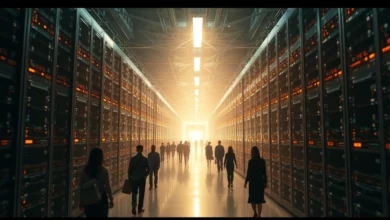The Great Leveling: Generative AI as a Democratizing Force

The landscape of professional value and competitive advantage is undergoing a seismic shift, driven by the advent of generative artificial intelligence. This powerful technology isn’t just an incremental improvement; it marks a fundamental inflection point, where innate creativity and cognitive flexibility are becoming more valuable than accumulated, domain-specific experience.
Generative AI is proving to be a great leveler, amplifying the capabilities of creative novices. Its potential is often constrained, however, by the ingrained habits and psychological defenses of seasoned professionals. This dynamic is reshaping industries and offering an unexpected edge to newcomers.
The Great Leveling: Generative AI as a Democratizing Force
Generative AI is systematically dismantling the high barriers of technical skill and resource access that have historically defined professional domains. This technological leveling is the primary mechanism through which a novice with a powerful idea can now directly compete with, and even outperform, a seasoned veteran reliant on established methods.
This innovative branch of artificial intelligence is fundamentally re-architecting the landscape of creation by making advanced technologies “accessible to everyone,” not just credentialed experts or large corporations. It’s “opening doors to possibilities that were once limited to human imagination,” effectively lowering the cost and complexity of turning a concept into a tangible output across various fields.
From generating human-like text for marketing copy to creating stunning images with simple descriptions, or even assisting in software development, generative AI empowers the non-specialist. Tools like Canva and Adobe Express, enhanced with AI features, enable users to produce professional-grade work “without extensive design expertise.”
The most critical consequence is a re-evaluation of where true value lies. Generative AI directly challenges the economic premium placed on technical mastery by simplifying the execution of complex concepts. The focus shifts from the ‘how’ of creation to the ‘what’ and the ‘why’ – from mastering intricate software to the quality and originality of the initial vision.
This democratization rapidly commoditizes purely technical, executional skills. As generative AI automates complex and repetitive tasks, the barrier to entry for producing high-quality work plummets. Therefore, competitive advantage no longer resides in tool precision but in the strategic and imaginative capacity to conceive the prompt, curate the output, and integrate results into a larger vision. This becomes the exclusive domain of “real creative people.”
The Expert’s Paradox: Cognitive Rigidity in the AI Era
While generative AI presents a landscape of opportunity for those with a clean slate, for many experienced professionals, it represents a fundamental threat. The observed resistance from established artists and developers is a predictable psychological response to a disruptive force challenging their economic value and professional identity.
A powerful framework for understanding this is threat-rigidity theory, which posits that perceived threats trigger cognitive and behavioral rigidity. For an incumbent professional, the digital-AI transformation can be seen as a direct threat to job security and the value of hard-won expertise, leading to a narrowed focus on avoiding losses rather than pursuing gains.
This tendency is compounded by cognitive entrenchment. Decades of experience, while building expertise, can also be a “double-edged sword” that erodes cognitive flexibility. The more expert one becomes, the “more locked-in we tend to become in our ways of thinking and doing things,” often manifesting as confirmation bias.
This explains why a 20-year veteran might be “afraid of going out of the pre-designed pattern.” Their success was built on mastering that pattern, and deviating from it can feel like a betrayal of their defining expertise. This psychological dynamic often manifests as widespread criticism, sometimes from those who haven’t even engaged with the technology.
The resistance to generative AI is often not about the difficulty of learning a new tool; it’s an identity crisis. For professionals whose identities are forged over decades of mastering a specific craft, a technology that democratizes that craft is an existential threat, attacking the very foundation of their professional self-worth. It triggers a defensive, rigid response, rejecting the new, threatening paradigm.
The Novice’s Edge: Unlocking Unprecedented Productivity
The theoretical arguments for the ascendancy of creative newcomers over entrenched experts are strongly supported by quantitative data on workplace productivity. Studies consistently show that generative AI acts as a skill-leveling force, providing disproportionately large benefits to those with the least experience.
Key findings indicate a quantifiable productivity chasm, with studies revealing that novice and low-skilled workers experience performance gains of up to 34% with AI assistance, while the impact on highly experienced experts is minimal. This disparity is rooted in the psychological phenomenon of cognitive rigidity, where deep expertise can foster an unwillingness to deviate from established patterns—a liability in an era of rapid technological change.
Conversely, individuals with a “beginner’s mind,” unburdened by preconceived notions, are better positioned to experiment, learn, and leverage AI’s full potential. Research from Stanford’s Human-Centered AI Institute corroborated this, finding that agents with just two months of tenure using AI could perform as well as agents with six months of tenure who did not, effectively compressing the experience curve.
The AI model acts as a conduit, disseminating the “potentially tacit knowledge of more able workers” and making it accessible to everyone. For experts, AI suggestions often reflect knowledge they already possess. For novices, it’s an instant infusion of expertise, an on-demand mentor guiding them through complex problems in real time.
This quantitative data finds its qualitative explanation in the concept of the “beginner’s mind,” or shoshin. It’s the practice of approaching situations with curiosity and openness, free from preconceptions. Adopting this mindset means being willing to “explore without prescription” and “get comfortable with making mistakes”—a direct contrast to professionals often paralyzed by the fear of failure.
The primary function of generative AI in a professional context is not just task automation; it’s the codification and dissemination of expert tacit knowledge. It captures collective best practices and problem-solving patterns, making implicit wisdom explicitly available. For the novice, this is a quantum leap in capability, instantly bestowing the functional equivalent of years of experience.
Forging the Future: AI-Native Enterprises Lead the Way
These theoretical and psychological shifts are not abstract future predictions; they are observable realities embodied in a new class of “AI-native” companies. These organizations operate under a completely different economic and structural logic, demonstrating how a small team of creative visionaries can achieve scale previously exclusive to large corporations.
This shift is most vividly illustrated by the emergence of hyper-lean, “AI-native” enterprises. Companies like Midjourney are achieving revenues of approximately $200 million with a team of just 11, demonstrating a new economic physics where scale is decoupled from headcount. These organizations are built not on methodical execution but on the creative vision of individuals using AI as a native extension of their ideation.
This new model represents a fundamental shift “from workforce to workflow.” Traditional companies scale by hiring more employees, but AI-native companies scale by automating core workflows. This allows them to serve millions of users with near-zero marginal cost, making them extraordinarily capital-efficient and disrupting traditional investment models.
The “20 year old with Cursor” is an archetype of the new AI-native developer. The emergence of “vibe coding” and agentic development tools allows developers to focus on architectural design and user intent, while AI handles boilerplate code and debugging. This enables small, agile teams or even individuals to build complex applications at unimaginable speeds.
The most profound long-term impact of AI on business is the decoupling of scale from headcount. AI-native companies shatter this paradigm, using AI systems for core functions like customer interaction and product generation. This allows the human team to remain small, agile, and focused on high-level strategy, creating exponential value on a flat cost base. A small, creative entity can now “outcompete by miles traditional professionals.”
Conclusion
The generative AI revolution is fundamentally redefining professional value. The democratization of advanced creative and technical tools has commoditized executional skill, shifting the locus of value toward conceptual vision and strategic ideation. This technological shift exposes a critical vulnerability in experienced professionals, whose cognitive rigidity and identity-based resistance often hinder their adaptation.
This is not a speculative forecast; it is a reality quantified in productivity data, showing novices consistently and dramatically outperforming experts when augmented by AI. This new paradigm is already being leveraged by a vanguard of AI-native enterprises achieving unprecedented scale and efficiency with radically lean teams.
The AI revolution is not about replacing human workers with machines; it is about augmenting creative human minds. The true beneficiaries will be those who possess the “beginner’s mind”—the deep-seated curiosity to ask novel questions, the cognitive flexibility to integrate new paradigms without fear, and the creative vision to direct these astonishingly powerful tools toward new frontiers.
Experience remains valuable, but its utility is now conditional. It is only powerful when paired with a genuine willingness to unlearn old methods and relearn new approaches in a state of perpetual evolution. To thrive, individuals and organizations must cultivate a culture of psychological safety, encouraging experimentation and continuous learning.
The future will not belong to the methodical professional who has perfected the processes of the past. It will belong to the visionary creator, the agile learner, and the intellectually fearless innovator who understands that their own creativity is the ultimate fuel for the AI models that are, and will remain, hungry for it.





